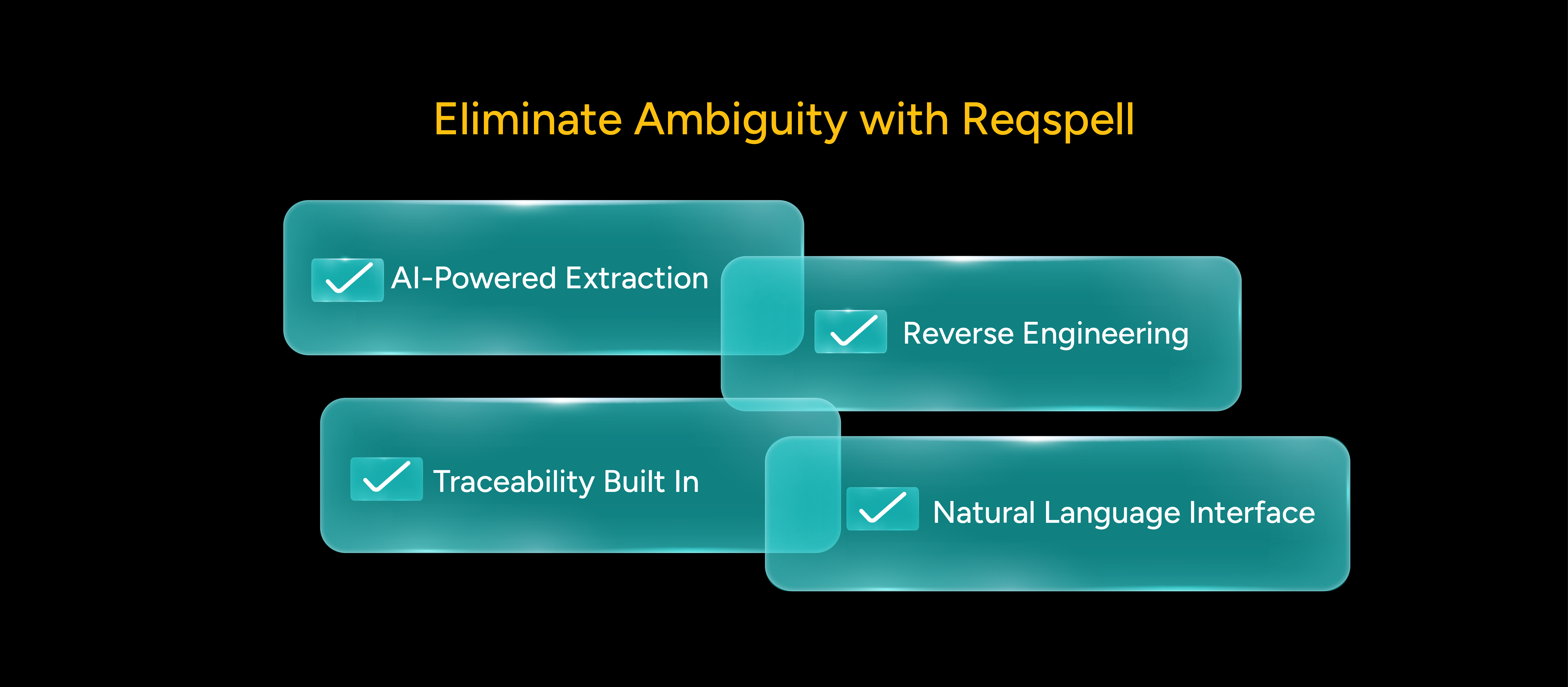December 1, 2025
TL;DR
Unclear requirements are one of the biggest hidden costs in software development. They slow down delivery, confuse teams, and create endless rework.
Reqspell eliminates this problem by using AI to extract, organize, and trace requirements from unstructured sources like documents, spreadsheets, and even legacy code.
The Price of Unclear Requirements
Every engineering team has felt it, the pain of building on vague specifications. A product document says one thing, a JIRA ticket says another, and the legacy code tells an entirely different story. The outcome? Weeks spent clarifying intent, rewriting test cases, and patching gaps that could have been avoided.
Ambiguity isn’t just a documentation issue; it’s an execution drag. It slows down releases, blurs accountability, and chips away at trust between product, engineering, and QA.
The worst part is teams often don’t realize how much time and focus they lose to ambiguity because it’s scattered across hundreds of small moments clarifying a story, tracing a requirement, or explaining “what this feature was supposed to do.”
Why Ambiguity Persists
Despite modern tools, most organizations still handle requirements the old-fashioned way manually, inconsistently, and across silos.
- Requirements live in emails, PDFs, spreadsheets, and chat threads.
- Codebases evolve without updated documentation.
- Test plans rarely map cleanly to the features they validate.
Even with systems like JIRA or Confluence, the data inside is still unstructured and fragmented. Tools manage the workflow but not the understanding.
This gap is exactly what Reqspell was built to solve.
Reqspell: Turning Ambiguity into Alignment
Reqspell is a requirement workflow enabler built for modern teams.
It brings clarity to product, engineering, and QA by extracting, organizing, and managing requirements from unstructured sources like legacy codebases, test plans, and product documents.
Here’s how it helps every team:
- Product Teams: Convert scattered notes and specifications into structured, queryable requirements.
- Engineering Teams: Understand system logic and dependencies without digging through code.
- QA Teams: Map test cases directly to requirements, surface coverage gaps, and ensure validation aligns with business goals
Reqspell doesn’t ask teams to work differently it simply reveals the structure already hidden in their work.
How Reqspell Eliminates Ambiguity
Reqspell uses AI to make sense of complexity. Every capability is designed to address a real-world challenge that causes confusion across teams.
- AI-Powered Extraction
Automatically converts documents, release notes, code comments, and spreadsheets into structured, searchable requirements. - Reverse Engineering
Analyzes legacy codebases to identify modules, dependencies, and functional scope no manual code tracing required. - Traceability Built In
Creates a continuous thread from product features to requirements to user stories to test cases. - Natural Language Interface
Enables anyone to query their product data like: “What are the functional requirements for payments?” or “Which tests cover login edge cases?”.

By combining these capabilities, Reqspell removes uncertainty from every stage of the SDLC turning disconnected inputs into a unified view of what’s being built and why.
Built to Fit Your Workflow.
Reqspell integrates with the tools your teams already use:
GitHub, GitLab, JIRA, Confluence, Google Docs, Sheets, TestRail, and Zephyr. Its design philosophy is simple structure should appear where you already work.
That’s how Reqspell brings alignment without disruption.
And when every requirement is connected across documentation, code, and tests the entire team gains shared context. That’s where productivity and speed naturally follow.
“Replace scattered inputs with structure, confusion with alignment, and ambiguity with traceable requirements.”
Improve Speed with Better Clarity
Ambiguous requirements don’t just slow teams down; they make progress unpredictable.
Reqspell changes that by making clarity the default state not a lucky outcome.
With structured, traceable requirements, product teams make decisions faster, engineers build with context, and QA validates with confidence.
In a world where delivery cycles are shrinking and complexity is rising, clarity isn’t optional it’s a competitive advantage.
Reqspell gives you that advantage.


.png)







.png)